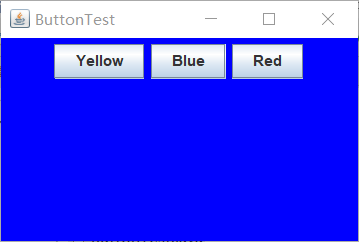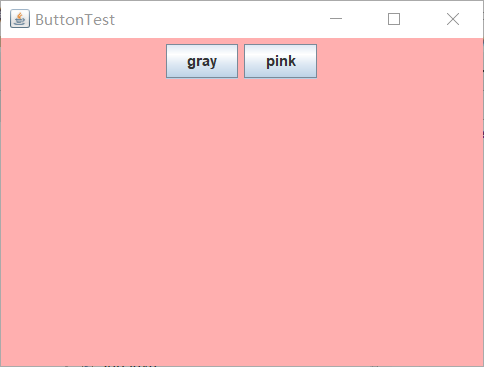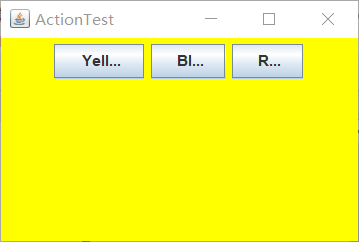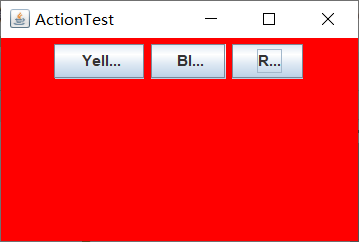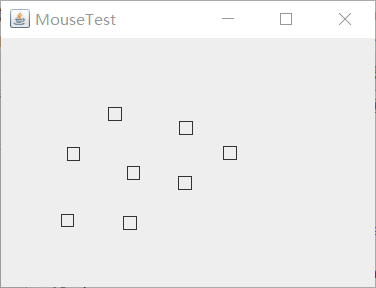| 项目 |
内容 |
| 这个作业属于哪个课程 |
<任课教师博客主页链接>https://www.cnblogs.com/nwnu-daizh/ |
| 这个作业的要求在哪里 |
<作业链接地址>https://www.cnblogs.com/nwnu-daizh/p/118568.html |
| 作业学习目标 |
(1) 掌握事件处理的基本原理,理解其用途; (2) 掌握AWT事件模型的工作机制; (3) 掌握事件处理的基本编程模型; (4) 了解GUI界面组件观感设置方法; (5) 掌握WindowAdapter类、AbstractAction类的用法; (6) 掌握GUI程序中鼠标事件处理技术。 |
第一部分:理论知识学习部分
第11章 事件处理
11.1 事件处理基础
- 事件源(event source):能够产生事件的对象都可 以成为事件源,如文本框、按钮等。一个事件源是一个 能够注册监听器并向监听器发送事件对象的对象。
- 事件监听器(event listener):事件监听器对象接 收事件源发送的通告(事件对象),并对发生的事件作 出响应。一个监听器对象就是一个实现了专门监听器接 口的类实例,该类必须实现接口中的方法,这些方法当 事件发生时,被自动执行。
- 事件对象(event object):Java将事件的相关信息 封装在一个事件对象中,所有的事件对象都最终派生于 java.util.EventObject类。不同的事件源可以产生不 同类别的事件。
-
1、AWT事件处理机制的概要:
1>监听器对象是一个实现了特定监听器接口的类的实例;
2>事件源是一个能够注册监听器对象并发送事件对象的对象;
3>当事件发生时,事件源将事件对象传递给所有注册的监听器;
4>监听器对象将利用事件对象中的信息决定如何对事件做出响应
-
GUI设计中,程序员需要对组件的某种事件进行响应和处理时,必须完成两个步骤:
1> 定义实现某事件监听器接口的事件监听器类,具体化接口中声明的事件处理抽象方法。
2>为组件注册实现了规定接口的事件监听器对象;
- 注册监听器方法 eventSourceObject.addEventListener(eventListenerObject)。
-
下面是监听器的一个示例: ActionListener listener = …;
JButton button=new JButton(“Ok”); button.addActionListener(listener);
-
动作事件(ActionEvent):当特定组件动作(点 击按钮)发生时,该组件生成此动作事件。
该 事 件 被 传 递 给 组 件 注 册 的 每 一 个 ActionListener 对象, 并 调 用 监 听 器 对 象 的 actionPerformed方法以接收这类事件对象。
能够触发动作事件的动作,主要包括:
(1) 点击按钮
(2) 双击一个列表中的选项;
(3) 选择菜单项;
(4) 在文本框中输入回车。
11.2 动作
- 动作事件
激活一个命令可以有多种方式,如用户可以通过菜单、击键或工具栏上的按钮选择特定的功能。
在AWT事件模型中,可设置用不同方式下达命令: (如:点击按钮、菜单选项、按下键盘),其操作动作都是一-样的。
- 动作接口及其类
Swing包提供了非常实用的机制来封装动作命令,并将它们连接到多个事件源,这就是Action接口。
动作对象是一个封装下列内容的对象:1.命令的说明: 一个文本字符串和一个可选图标;2.执行命令所需要的参数。
Action扩展于ActionListener接口,包含下列方法:
void act ionPerformed (Act ionEvent event)void setEnabled(bool ean b);
void isEnabled();
void putValue (String key, 0bject va lue);
void getValue (String key);
void addPropertyChangeListner (ProperChangeL istener listener);
void removePropertyChangeListener (Pr operChangeListener listener);
Action是一个接口,而不是一个类,实现这个接口的类必须要实现它的7个方法。
AbstractAction类实现了Action接口中除actionPerformed方法之外的所有方法,这个类存储了所有名/值对,并管理着属性变更监听器。
在动作事件处理应用中,可以直接扩展AbstractAction类,并在扩展类中实现act ionPerformed方法。
- 击键关联映射
将一个动作对象添加到击键中,以便让用户敲击键盘命令来执行这个动作。
将动作与击键关联起来,需生成KeyStroke类对象。
KeyStroke ctrBKey = KeyStroke.getKeyStroke("Ctrl B");
下面是将击键与动作对象关联起来的方式(桥梁:动作键对象描述字符串)
InputMap imap = buttonPanel.getInputMap(JComponent.WHEN_ ANCESTOR_ OF_FOCUSED_ COMPONENT);
imap.put(KeyStroke. getKeyStroke("ctrl Y"), "panel.yellow");
ActionMap amap = buttonPanel.getActionMap();
amap.put("panel,.yellow", yellowAction);
11.3 鼠标事件
a)鼠标事件 – MouseEvent
b)鼠标监听器接口 – MouseListener – MouseMotionListener
c) 鼠标监听器适配器 – MouseAdapter – MouseMotionAdapter
11.4 AWT事件继承层次
a) 所有的事件都是由java.util包中的EventObject 类扩展而来。
b) AWTEevent 是所有AWT 事件类的父类, 也是 EventObject的直接子类。
c) 有些Swing组件生成其他类型的事件对象,一般直 接 扩 展 于 EventObject, 而不是AWTEvent,位于 javax.swing.event.*。
d) 事件对象封装了事件源与监听器彼此通信的事件 信息。在必要的时候,可以对传递给监听器对象的 事件对象进行分析。
第二部分:实验部分
实验1: 导入第11章示例程序,测试程序并进行代码注释。
测试程序1:
l 在elipse IDE中调试运行教材443页-444页程序11-1,结合程序运行结果理解程序;
l 在事件处理相关代码处添加注释;
l 用lambda表达式简化程序;
l 掌握JButton组件的基本API;
l 掌握Java中事件处理的基本编程模型。
代码如下:
ButtonFrame.java:
|
1
2
3
4
5
6
7
8
9
10
11
12
13
14
15
16
17
18
19
20
21
22
23
24
25
26
27
28
29
30
31
32
33
34
35
36
37
38
39
40
41
42
43
44
45
46
47
48
49
50
51
52
53
54
55
56
57
58
59
60
61
62
63
|
package
button;
import
java.awt.*;
import
java.awt.event.*;
import
javax.swing.*;
/**
* 一个带按钮面板的框架
*/
public
class
ButtonFrame
extends
JFrame
{
private
JPanel buttonPanel;
//定义JPanel属性
private
static
final
int
DEFAULT_WIDTH =
300
;
private
static
final
int
DEFAULT_HEIGHT =
200
;
public
ButtonFrame()
{
setSize(DEFAULT_WIDTH, DEFAULT_HEIGHT);
//setSize更改宽度和高度的属性值
// 创建按钮
var yellowButton =
new
JButton(
"Yellow"
);
var blueButton =
new
JButton(
"Blue"
);
var redButton =
new
JButton(
"Red"
);
buttonPanel =
new
JPanel();
//使new JPanel指向对象buttonPanel
//在面板中添加按钮,使用add方法
buttonPanel.add(yellowButton);
buttonPanel.add(blueButton);
buttonPanel.add(redButton);
// 添加面板到框架
add(buttonPanel);
//创建按钮动作
var yellowAction =
new
ColorAction(Color.YELLOW);
var blueAction =
new
ColorAction(Color.BLUE);
var redAction =
new
ColorAction(Color.RED);
//用按钮关联动作,监听器对象与组件之间的注册机制
yellowButton.addActionListener(yellowAction);
blueButton.addActionListener(blueAction);
redButton.addActionListener(redAction);
}
/**
* 设置面板背景颜色的动作侦听器
*/
private
class
ColorAction
implements
ActionListener
{
private
Color backgroundColor;
public
ColorAction(Color c)
{
backgroundColor = c;
}
public
void
actionPerformed(ActionEvent event)
{
buttonPanel.setBackground(backgroundColor);
}
}
}
|
ButtonTest.java:
|
1
2
3
4
5
6
7
8
9
10
11
12
13
14
15
16
17
18
19
20
21
|
package
button;
import
java.awt.*;
import
javax.swing.*;
/**
* @version 1.35 2018-04-10
* @author Cay Horstmann
*/
public
class
ButtonTest
{
public
static
void
main(String[] args)
{
EventQueue.invokeLater(() -> {
var frame =
new
ButtonFrame();
//生成ButtonFrame对象
frame.setTitle(
"ButtonTest"
);
//设置组建的自定义标题测试按钮
frame.setDefaultCloseOperation(JFrame.EXIT_ON_CLOSE);
//设置默认的关闭操作,参数在关闭动作时退出
frame.setVisible(
true
);
//图形界面设置为可见
});
}
}
|
实验结果如图:
lambda表达式简化程序:
ButtonFrame1.java:
|
1
2
3
4
5
6
7
8
9
10
11
12
13
14
15
16
17
18
19
20
21
22
23
24
25
26
27
28
29
30
31
32
33
34
35
36
37
38
39
40
41
42
43
44
45
46
47
48
49
50
|
package
button;
import
java.awt.*;
import
java.awt.event.*;
import
javax.swing.*;
/**
* 一个带按钮面板的框架
*/
public
class
ButtonFrame1
extends
JFrame {
private
JPanel buttonPanel;
//定义JPanel属性
private
static
final
int
DEFAULT_WIDTH =
400
;
private
static
final
int
DEFAULT_HEIGHT =
300
;
public
ButtonFrame1() {
setSize(DEFAULT_WIDTH, DEFAULT_HEIGHT);
//setSize更改宽度和高度的属性值
buttonPanel =
new
JPanel();
//使new JPanel指向对象buttonPanel
makeButton(
"gray"
, Color.gray);
makeButton(
"pink"
, Color.pink);
add(buttonPanel);
}
protected
void
makeButton(String name,Color backgound) {
//创建按钮
JButton button =
new
JButton(name);
//在面板中添加按钮,使用add方法
buttonPanel.add(button);
//Lambda表达式
button.addActionListener((e)->{
buttonPanel.setBackground(backgound);
});
}
/**
* 设置面板背景颜色的动作侦听器
*/
/*private class ColorAction implements ActionListener {
private Color backgroundColor;
public ColorAction(Color c) {
backgroundColor = c;
}
public void actionPerformed(ActionEvent event) {
buttonPanel.setBackground(backgroundColor);
}
}*/
}
|
运行结果如图:
测试程序2:
l 在elipse IDE中调试运行教材449页程序11-2,结合程序运行结果理解程序;
l 在组件观感设置代码处添加注释;
l 了解GUI程序中观感的设置方法。
实验代码如下:
PlafFrame.java:
|
1
2
3
4
5
6
7
8
9
10
11
12
13
14
15
16
17
18
19
20
21
22
23
24
25
26
27
28
29
30
31
32
33
34
35
36
37
38
39
40
41
42
43
44
45
46
47
48
49
50
51
52
53
54
55
|
package
plaf;
import
javax.swing.JButton;
import
javax.swing.JFrame;
import
javax.swing.JPanel;
import
javax.swing.SwingUtilities;
import
javax.swing.UIManager;
/**
*带有按钮面板的框架,用于改变外观和感觉
*/
public
class
PlafFrame
extends
JFrame
{
private
JPanel buttonPanel;
public
PlafFrame()
{
buttonPanel =
new
JPanel();
//获取所有的显示样式UIManager.setLookAndFeel(infos[0].getClassName())
UIManager.LookAndFeelInfo[] infos = UIManager.getInstalledLookAndFeels();
for
(UIManager.LookAndFeelInfo info : infos)
makeButton(info.getName(), info.getClassName());
add(buttonPanel);
//增加按键点击事件
pack();
}
/**
* 制作一个按钮来改变可插入的外观和感觉。
* @param name the button name
* @param className the name of the look-and-feel class
*/
private
void
makeButton(String name, String className)
{
// 添加按钮至Panel
JButton button =
new
JButton(name);
buttonPanel.add(button);
//设置按钮操作
button.addActionListener(event -> {
// 按钮操作:切换到新的外观和感觉
try
{
//设置成你所使用的平台的外观。 java的图形界面外观有3种,默认是java的金属外观,还有就是windows系统,motif系统外观.
UIManager.setLookAndFeel(className);
SwingUtilities.updateComponentTreeUI(
this
);
pack();
//依据放置的组件设定窗口的大小, 使之正好能容纳放置的所有组件
}
catch
(Exception e)
//抛出异常
{
e.printStackTrace();
//深层次的输出异常调用的流程
}
});
}
}
|
PlafTest.java:
|
1
2
3
4
5
6
7
8
9
10
11
12
13
14
15
16
17
18
19
20
21
|
package
plaf;
import
java.awt.*;
import
javax.swing.*;
/**
* @version 1.32 2015-06-12
* @author Cay Horstmann
*/
public
class
PlafTest
{
public
static
void
main(String[] args)
{
EventQueue.invokeLater(() -> {
JFrame frame =
new
PlafFrame();
//生成PlafFrame对象
frame.setTitle(
"PlafTest"
);
//设置组建的自定义标题测试按钮
frame.setDefaultCloseOperation(JFrame.EXIT_ON_CLOSE);
//设置默认的关闭操作
frame.setVisible(
true
);
});
}
}
|
运行结果如图:
测试程序3:
l 在elipse IDE中调试运行教材457页-458页程序11-3,结合程序运行结果理解程序;
l 掌握AbstractAction类及其动作对象;
l 掌握GUI程序中按钮、键盘动作映射到动作对象的方法。
实验代码如下:
ActionFrame.java:
|
1
2
3
4
5
6
7
8
9
10
11
12
13
14
15
16
17
18
19
20
21
22
23
24
25
26
27
28
29
30
31
32
33
34
35
36
37
38
39
40
41
42
43
44
45
46
47
48
49
50
51
52
53
54
55
56
57
58
59
60
61
62
63
64
65
66
67
68
69
70
71
|
package
action;
import
java.awt.*;
import
java.awt.event.*;
import
javax.swing.*;
/**
* 具有显示颜色变化动作的面板的框架
*/
public
class
ActionFrame
extends
JFrame
{
private
JPanel buttonPanel;
private
static
final
int
DEFAULT_WIDTH =
300
;
private
static
final
int
DEFAULT_HEIGHT =
200
;
public
ActionFrame()
{
setSize(DEFAULT_WIDTH, DEFAULT_HEIGHT);
//设置宽度和高度
buttonPanel =
new
JPanel();
var yellowAction =
new
ColorAction(
"Yellow"
,
new
ImageIcon(
"yellow-ball.gif"
),
Color.YELLOW);
var blueAction =
new
ColorAction(
"Blue"
,
new
ImageIcon(
"blue-ball.gif"
), Color.BLUE);
var redAction =
new
ColorAction(
"Red"
,
new
ImageIcon(
"red-ball.gif"
), Color.RED);
//创建一个按钮,其属性从所提供的 Action中获取
buttonPanel.add(
new
JButton(yellowAction));
buttonPanel.add(
new
JButton(blueAction));
buttonPanel.add(
new
JButton(redAction));
//将添加好按钮的面板添加到原框架中
add(buttonPanel);
// associate the Y, B, and R keys with names
InputMap inputMap = buttonPanel.getInputMap(JComponent.WHEN_ANCESTOR_OF_FOCUSED_COMPONENT);
inputMap.put(KeyStroke.getKeyStroke(
"ctrl Y"
),
"panel.yellow"
);
inputMap.put(KeyStroke.getKeyStroke(
"ctrl B"
),
"panel.blue"
);
inputMap.put(KeyStroke.getKeyStroke(
"ctrl R"
),
"panel.red"
);
// associate the names with actions
ActionMap actionMap = buttonPanel.getActionMap();
actionMap.put(
"panel.yellow"
, yellowAction);
actionMap.put(
"panel.blue"
, blueAction);
actionMap.put(
"panel.red"
, redAction);
}
public
class
ColorAction
extends
AbstractAction
{
/**
*构造颜色动作
* @param name the name to show on the button
* @param icon the icon to display on the button
* @param c the background color
*/
public
ColorAction(String name, Icon icon, Color c)
{
putValue(Action.NAME, name);
putValue(Action.SMALL_ICON, icon);
putValue(Action.SHORT_DESCRIPTION,
"Set panel color to "
+ name.toLowerCase());
putValue(
"color"
, c);
//在构造器中设置一些键值对映射,这些设置的属性将会被JPanel读取
}
public
void
actionPerformed(ActionEvent event)
{
var color = (Color) getValue(
"color"
);
buttonPanel.setBackground(color);
//设置背景颜色
}
}
}
|
ActionTest.java:
|
1
2
3
4
5
6
7
8
9
10
11
12
13
14
15
16
17
18
19
20
21
|
package
action;
import
java.awt.*;
import
javax.swing.*;
/**
* @version 1.34 2015-06-12
* @author Cay Horstmann
*/
public
class
ActionTest
{
public
static
void
main(String[] args)
{
EventQueue.invokeLater(() -> {
var frame =
new
ActionFrame();
frame.setTitle(
"ActionTest"
);
//设置标题
frame.setDefaultCloseOperation(JFrame.EXIT_ON_CLOSE);
frame.setVisible(
true
);
});
}
}
|
运行结果如图:
测试程序4:
l 在elipse IDE中调试运行教材462页程序11-4、11-5,结合程序运行结果理解程序;
l 掌握GUI程序中鼠标事件处理技术。
实验代码如下:
MouseComponent.java:
|
1
2
3
4
5
6
7
8
9
10
11
12
13
14
15
16
17
18
19
20
21
22
23
24
25
26
27
28
29
30
31
32
33
34
35
36
37
38
39
40
41
42
43
44
45
46
47
48
49
50
51
52
53
54
55
56
57
58
59
60
61
62
63
64
65
66
67
68
69
70
71
72
73
74
75
76
77
78
79
80
81
82
83
84
85
86
87
88
89
90
91
92
93
94
95
96
97
98
99
100
101
102
103
104
105
106
107
108
109
110
111
112
113
114
115
116
117
118
119
120
121
122
123
124
125
126
127
128
129
|
package
mouse;
import
java.awt.*;
import
java.awt.event.*;
import
java.awt.geom.*;
import
java.util.*;
import
javax.swing.*;
/**
* 一个带有鼠标操作的用于添加和删除正方形的组件。
*/
public
class
MouseComponent
extends
JComponent
{
private
static
final
int
DEFAULT_WIDTH =
300
;
private
static
final
int
DEFAULT_HEIGHT =
200
;
private
static
final
int
SIDELENGTH =
10
;
private
ArrayList
//声明一个正方形集合
private
Rectangle2D current;
// java类库中用来描述矩形的类,它的对象可以看作是一个矩形
public
MouseComponent()
{
squares =
new
ArrayList<>();
current =
null
;
addMouseListener(
new
MouseHandler());
// 添加一个我们实现的类,这个类继承了监测鼠标点击情况的MouseListener
addMouseMotionListener(
new
MouseMotionHandler());
// 添加另一个实现类,这个类继承了监测鼠标移动情况的MouseMotionListener
}
public
Dimension getPreferredSize()
{
return
new
Dimension(DEFAULT_WIDTH, DEFAULT_HEIGHT);
}
public
void
paintComponent(Graphics g)
{
var g2 = (Graphics2D) g;
// 绘制所有的正方形
for
(Rectangle2D r : squares)
g2.draw(r);
}
/**
* 判断在这个坐标上是否有图形
* @param p a point
* @return the first square that contains p
*/
public
Rectangle2D find(Point2D p)
{
for
(Rectangle2D r : squares)
{
if
(r.contains(p))
return
r;
//contains方法:测定坐标是否在图形的边界内
}
return
null
;
}
/**
* 在这个坐标位置增加一个图形 .
* @param p the center of the square
*/
public
void
add(Point2D p)
{
//获取x,y的坐标
double
x = p.getX();
double
y = p.getY();
current =
new
Rectangle2D.Double(x - SIDELENGTH /
2
, y - SIDELENGTH /
2
,
SIDELENGTH, SIDELENGTH);
//用获得的坐标和既定的边长构建一个新的正方形,并将其赋值给current
squares.add(current);
repaint();
}
/**
* 从集合中移除正方形
* @param s the square to remove
*/
public
void
remove(Rectangle2D s)
{
if
(s ==
null
)
return
;
//移除内容为空,返回
if
(s == current) current =
null
;
//如果要移除的内容和current正指向的内容相同,则将current清空
squares.remove(s);
repaint();
}
private
class
MouseHandler
extends
MouseAdapter
{
public
void
mousePressed(MouseEvent event)
{
// 如果光标不在正方形中,则添加一个新的正方形
current = find(event.getPoint());
if
(current ==
null
) add(event.getPoint());
}
public
void
mouseClicked(MouseEvent event)
{
// 如果双击,删除当前方块
current = find(event.getPoint());
if
(current !=
null
&& event.getClickCount() >=
2
) remove(current);
}
}
private
class
MouseMotionHandler
implements
MouseMotionListener
{
public
void
mouseMoved(MouseEvent event)
{
// set the mouse cursor to cross hairs if it is inside a rectangle设置鼠标光标
if
(find(event.getPoint()) ==
null
) setCursor(Cursor.getDefaultCursor());
else
setCursor(Cursor.getPredefinedCursor(Cursor.CROSSHAIR_CURSOR));
}
public
void
mouseDragged(MouseEvent event)
{
if
(current !=
null
)
{
//因为在调用这个方法之前肯定会调用点击鼠标的方法
//所以我们直接判断:如果现在current不为空
//像素(强制转换为int)
int
x = event.getX();
int
y = event.getY();
// drag the current rectangle to center it at (x, y)
current.setFrame(x - SIDELENGTH /
2
, y - SIDELENGTH /
2
, SIDELENGTH, SIDELENGTH);
repaint();
}
}
}
}
|
MouseTest.java:
|
1
2
3
4
5
6
7
8
9
10
11
12
13
14
15
16
17
18
19
20
21
|
package
mouse;
import
java.awt.*;
import
javax.swing.*;
/**
* @version 1.35 2018-04-10
* @author Cay Horstmann
*/
public
class
MouseTest
{
public
static
void
main(String[] args)
{
EventQueue.invokeLater(() -> {
var frame =
new
MouseFrame();
frame.setTitle(
"MouseTest"
);
frame.setDefaultCloseOperation(JFrame.EXIT_ON_CLOSE);
frame.setVisible(
true
);
});
}
}
|
MouseFrame.java:
|
1
2
3
4
5
6
7
8
9
10
11
12
13
14
15
|
package
mouse;
import
javax.swing.*;
/**
* A frame containing a panel for testing mouse operations
*/
public
class
MouseFrame
extends
JFrame
{
public
MouseFrame()
{
add(
new
MouseComponent());
//向框架中添加一个JComponent的实例
pack();
//依据放置的组件设定窗口的大小, 使之正好能容纳放置的所有组件
}
}
|
运行结果如下:
实验2:结对编程练习包含以下4部分:
1) 程序设计思路简述;
2) 符合编程规范的程序代码;
3) 程序运行功能界面截图;
4) 结对过程描述,提供两人在讨论、细化和编程时的结对照片(非摆拍)。
代码如下:
Test.java:
nameRardom.java:
|
1
2
3
4
5
6
7
8
9
10
11
12
13
14
15
16
17
18
19
20
21
22
23
24
25
26
27
28
29
30
31
32
33
34
35
36
37
38
39
40
41
42
43
44
45
46
47
48
49
50
51
52
53
54
55
56
57
58
59
60
61
62
63
64
65
66
67
68
69
70
|
import
java.awt.Color;
import
java.awt.Container;
import
java.awt.event.*;
import
java.io.*;
import
java.util.*;
import
java.util.Timer;
import
javax.swing.*;
public
class
nameRardom
extends
JFrame {
private
ArrayList arrayList;
{
arrayList =
new
ArrayList<>();
//读文件
File file =
new
File(
"D:/2019studentlist.txt"
);
FileInputStream fis;
try
{
fis =
new
FileInputStream(file);
InputStreamReader in =
new
InputStreamReader(fis);
BufferedReader buf =
new
BufferedReader(in);
String readLine;
while
((readLine = buf.readLine())!=
null
) {
arrayList.add(readLine);
}
}
catch
(FileNotFoundException e1) {
e1.printStackTrace();
}
catch
(IOException e1) {
e1.printStackTrace();
}
}
private
JPanel a;
private
static
final
int
DEFAULT_WIDTH =
500
;
private
static
final
int
DEFAULT_HEIGHT =
300
;
public
nameRardom() {
setSize(DEFAULT_WIDTH, DEFAULT_HEIGHT);
a =
new
JPanel();
a.setLayout(
null
);
JLabel jLabel =
new
JLabel(
"随机点名器"
);
JButton jButton =
new
JButton(
"开始"
);
jLabel.setBounds(
200
,
50
,
65
,
40
);
jButton.setBounds(
200
,
90
,
65
,
40
);
jButton.addActionListener(
new
ActionListener() {
Timer timer;
public
void
actionPerformed(ActionEvent e) {
if
(jButton.getText().equals(
"开始"
)) {
timer =
new
Timer();;
TimerTask timerTask =
new
TimerTask() {
public
void
run() {
jButton.setText(
"停止"
);
jButton.setBackground(Color.pink);
jLabel.setText((String) arrayList.get((
int
) (Math.random() *
35
)));
}
};
timer.schedule(timerTask,
0
,
100
);
}
if
(jButton.getText().equals(
"停止"
)) {
timer.cancel();
jButton.setText(
"开始"
);
jButton.setBackground(Color.LIGHT_GRAY);
}
}
});
a.add(jLabel);
a.add(jButton);
add(a);
}
}
|

